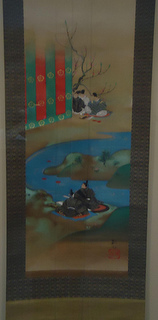Difference between revisions of "Gosekku"
(Created page with "right|thumb|320px|One of a set of hanging scrolls depicting the ''gosekku'', by [[Ikeda Koson, c. 1830. Freer Gallery of Art.]] *''Japanese'': 五...") |
(No difference)
|
Revision as of 05:00, 30 July 2013

- Japanese: 五節句 (gosekku)
The gosekku (lit. "five seasonal festivals") were five of the most important seasonal rites performed by the Imperial Court.
Around New Year's, courtiers processed before the emperor in a ritual known as the Kochohai festival.
The Kyokusui Festival, performed on 3/3, emulated the famous Orchid Pavilion gathering organized by Wang Xizhi in 353. In emulation of that event, courtiers composed poetry while floating wine cups down a stream in one of the palace gardens.
On 5/5, the Court observed an iris festival.
The festival celebrated on 7/7, today called Tanabata, was in the court traditionally called Kikkoden.
On 9/9, the Court observed a festival in connection with the rice harvest; known as Choyo, the festival was related to one in China which involved the drinking of chrysanthemum wine.
References
- Gallery label, Freer Gallery of Art, "Gosekku: The Five Ancient Festivals of the Imperial Court," Ikeda Koson, set of five hanging scrolls, c. 1830, F1999.5.1a-f.